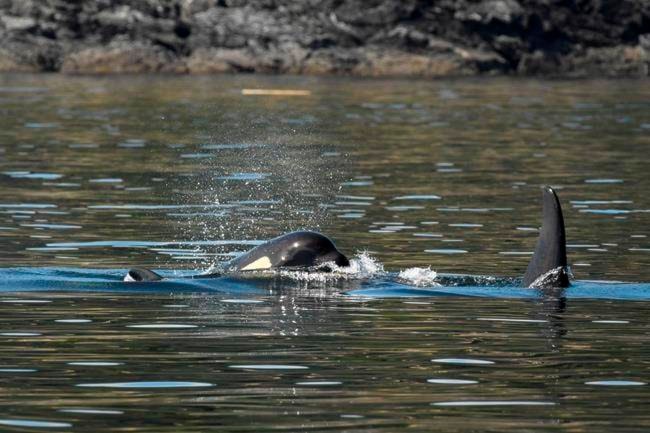American and Canadian scientists are considering a Hail Mary effort to save an endangered orca that may have only days to live.
The female killer whale known as J50 appears emaciated, lethargic and has lost about 20 per cent of her body weight, said Michael Milstein, spokesman for the National Oceanic and Atmospheric Administration in the United States.
J50 is one of just 75 remaining southern resident killer whales that travel the coastal waters from British Columbia to California.
“She’s a female about four years old and obviously very valuable to the population as a reproductive female, so we’re looking at all the possibilities for whether we could make a difference in her survival,” Milstein said. “The challenge is that the biologists are saying they haven’t seen a whale deteriorated to this point pull out of that before.”
Officials with both NOAA and the Department of Fisheries and Oceans Canada are considering options, including feeding the underweight killer whale chinook salmon with medication in it — a strategy the U.S. department believes hasn’t been used before.
At this stage, they are weighing whether intervening could be worse than doing nothing and are considering ways to feed the whale without encouraging a dependency on humans, Milstein said.
At the same time, the scientists are keenly aware that they’re racing against the clock.
“They feel the situation is dire, that she probably has potentially a matter of days. Nobody knows for sure, (and) if we were going to attempt something that we would need to do it pretty soon,” Milstein said.
OPINION: Grieving orca should inspire more than momentary sympathy
The first step is observing the whale to pinpoint her ailments with drone footage and by collecting fecal and breath samples from her blow hole, he said.
J50 has a syndrome called “peanut head,” where her head appears too small for her body. Biologists believe the syndrome occurs when orcas don’t get enough food and don’t develop properly. A white spot has also been observed near her blow hole, which could indicate an infection, he said.
Scientists were out on the water Thursday looking for J50’s pod, but the whales were last seen heading toward open water, he said.
Linda Rhodes, a research microbiologists at the Northwest Fisheries Science Center in Seattle, said researchers held a petri dish over J50’s blowhole to collect a sample of the spume on July 21.
While the emergency sample showed evidence of bacteria and fungus, it wasn’t enough to determine an infection because it could have come from the surrounding environment, she said. They’re hoping to collect some fresh samples when they find the pod again.
As a young female with reproductive potential, J50 could play a vital role in the survival of the species.
“That’s where the births would come from to help recover the population in the longer term,” Milstein said.
The same pod includes a whale known as J35 that has been seen as recently as Wednesday pushing the body of her deceased newborn calf through the water. The calf died shortly after birth on July 24.
The southern residents are facing threats from many angles, including chemical pollutants that accumulate in their blubber and noisy ship traffic that interferes with their communication. Chief among the concerns is the lack of availability of their primary food source, chinook salmon.
The Canadian government limited the chinook salmon fishery recently in an effort to help the recovery of the southern residents. It also imposed a minimum distance of 200 metres for vessels to stay away from killer whales in Canadian waters and is conducting research on the impact of pollution.
While Milstein was not aware of any other attempt to feed a struggling killer whale medicated salmon, he said the closest example was the rescue of an orphaned killer whale in 2002.
The northern resident killer whale known as Springer, or A73, made headlines around the world when she was reunited with her pod off the coast of British Columbia.
Springer was two years old when she was found in Puget Sound near Seattle, ailing and separated from her pod. She was the first orca to be rescued, rehabilitated and successfully released back into the wild.
The Canadian Press
